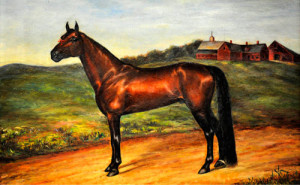Lost Trotting Parks of Maine
Welcome top the Lost Trotting Parks Heritage Center history Timeline. We hope you find this interesting to explore the great equine history in this region.
Winthrop Messenger 1819
Winthrop Messenger of Messenger Stock was purchased by Alan Hayward and brought to the village of Winthrop Maine.

Mac Foaled 1843
Mac, 2.27 –Mac was foaled on Moose Hill in East Livermore in 1843. His breeder was Thomas Record.
Thomas S. Lang Stables Started 1844
Thomas S. Lang Stables – North Vassalboro – The stable included the horses Gideon, son of Hambletonian and General Knox.
Bangor Trotting Park built 1851
1851 Bangor Trotting Park (now Bangor Public Works) was a mile track built in 1851.
General Knox purchased 1859
General Knox purchased by Thomas Lang in January of 1859 from a breeding establishment near the east shore of Lake Champlain in the town of Shoreham, Vermont.
Hopeful Foaled 1866
Hopeful, 2.14 ¾ --The Currier &Ives trotter Hopeful was foaled in 1866 on the North Dixmont farm of Eli Whitcomb.
General William S. Tilton 1872
General William S. Tilton was appointed Governor of the Togus Soldiers’ Home in 1869. One of his most important contributions was his research on the descendants of Winthrop Messenger which was published in the Maine Farmer in 1872
Emma B. Foaled 1872
Emma B, later renamed “Police Gazette” by Richard K. Fox who owned the tabloid New York newspaper of the same name, was foaled on the Foxcroft Farm of P.M. and C.E. Jefferds in 1872
Thomas S. Lang Stables 1874
1874 was the last year of Thomas S. Lang Stables – North Vassalboro – The stable included the horses Gideon, son of Hambletonian and General Knox.
Book, Noted Maine Horses 1874
J.W. Thompson (1844-1940) published his first volume of Noted Maine Horses in 1874. The book was updated in 1886. Thompson was also the editor of the Maine Horse Breeders’ Monthly.
George H. Bailey Graduates, 1880
George H. Bailey, D.V.S. (1832 – 1905) trained and drove noted trotters like Shepherd Knapp, Jr. and King William. He also managed tracks in Portland and Boston. He was an accomplished artist and in 1880 graduated first in his class from The American Veterinary College located in New York.
Cream Brook Farm 1880
Cream Brook Farm established by Greenville J. Shaw (1843 – 1903) established in 1880 was the subject of a Scott Leighton painting. His two most noted stallions were Gideon and General Withers.
Recluse Farm in 1881
Recluse Farm, the home of James and Jane Wadsworth is located in South Hiram, about four miles from the charming village of Cornish, Maine.
Maplewood Park Constructed 1883
Maplewood Park -- Now operated by Hollywood Slots, Maplewood Park also called Bass Park was constructed in 1883.

The Kite Track 1892
The Kite Track, originally named the Breeders’ Mile Track, formally opened on July 4, 1892. The track, in the shape of a kite, was located in Old Orchard Beach, Maine.
Rigby Park 1892
Described by its builder Seth Griffin as the fastest and safest regulation track in the world, Rigby Park opened its doors to the public in October of 1892.
Maple Grove Stock Farm 1893
Maple Grove Stock Farm in Auburn, Maine was the first stable in Maine to reduce stallion fees. The stable was owned by B.F. Briggs.
Nicholas Winfield Scott Leighton Dies 1898
Death of Maine born artist, Nicholas Winfield Scott Leighton, best known for at least thirty paintings that were used for lithographs published by Currier & Ives.
Death of Charles Horace Nelson 1915
The death of Charles Horace Nelson (1843 – 1015) – “With the passing of Charles Horace Nelson the race tracks of Maine lose its most famous figure and it is doubtful if ever again there rises a man in Maine who will bring such a personality and ability to the track as this man.”

